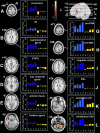Neural basis of aging: the penetration of cognition into action control
- PMID: 16033888
- PMCID: PMC6725362
- DOI: 10.1523/JNEUROSCI.1263-05.2005
Neural basis of aging: the penetration of cognition into action control
Abstract
Although functional imaging studies have frequently examined age-related changes in neural recruitment during cognitive tasks, much less is known about such changes during motor performance. In the present study, we used functional magnetic resonance imaging to investigate age-related changes in cyclical hand and/or foot movements across different degrees of complexity. Right-handed volunteers (11 young, 10 old) were scanned while performing isolated flexion-extension movements of the right wrist and foot as well as their coordination, according to the "easy" isodirectional and "difficult" nonisodirectional mode. Findings revealed activation of a typical motor network in both age groups, but several additional brain areas were involved in the elderly. Regardless of the performed motor task, the elderly exhibited additional activation in areas involved in sensory processing and integration, such as contralateral anterior insula, frontal operculum, superior temporal gyrus, supramarginal gyrus, secondary somatosensory area, and ipsilateral precuneus. Age-related activation differences during coordination of both segments were additionally observed in areas reflecting increased cognitive monitoring of motor performance, such as the pre-supplementary motor area, pre-dorsal premotor area, rostral cingulate, and prefrontal cortex. In the most complex coordination task, the elderly exhibited additional activation in anterior rostral cingulate and dorsolateral prefrontal cortex, known to be involved in suppression of prepotent response tendencies and inhibitory cognitive control. Overall, these findings are indicative of an age-related shift along the continuum from automatic to more controlled processing of movement. This increased cognitive monitoring of movement refers to enhanced attentional deployment, more pronounced processing of sensory information, and intersensory integration.
Figures





Similar articles
-
Intracerebral ERD/ERS in voluntary movement and in cognitive visuomotor task.Prog Brain Res. 2006;159:311-30. doi: 10.1016/S0079-6123(06)59021-1. Prog Brain Res. 2006. PMID: 17071240
-
Brain areas involved in interlimb coordination: a distributed network.Neuroimage. 2001 Nov;14(5):947-58. doi: 10.1006/nimg.2001.0892. Neuroimage. 2001. PMID: 11697927
-
Ipsilateral coordination at preferred rate: effects of age, body side and task complexity.Neuroimage. 2009 Oct 1;47(4):1854-62. doi: 10.1016/j.neuroimage.2009.06.027. Epub 2009 Jun 17. Neuroimage. 2009. PMID: 19539766
-
The microstructural border between the motor and the cognitive domain in the human cerebral cortex.Adv Anat Embryol Cell Biol. 2004;174:I-VIII, 1-89. doi: 10.1007/978-3-642-18910-4. Adv Anat Embryol Cell Biol. 2004. PMID: 14750415 Review.
-
fMRI studies of eye movement control: investigating the interaction of cognitive and sensorimotor brain systems.Neuroimage. 2007;36 Suppl 2(Suppl 2):T54-60. doi: 10.1016/j.neuroimage.2007.03.018. Epub 2007 Mar 27. Neuroimage. 2007. PMID: 17499170 Free PMC article. Review.
Cited by
-
Normal aging affects unconstrained three-dimensional reaching against gravity with reduced vertical precision and increased co-contraction: a pilot study.Exp Brain Res. 2022 Apr;240(4):1029-1044. doi: 10.1007/s00221-021-06280-9. Epub 2022 Feb 16. Exp Brain Res. 2022. PMID: 35171307 Free PMC article.
-
Neuroplastic Changes in Older Adults Performing Cooperative Hand Movements.Front Hum Neurosci. 2018 Dec 13;12:488. doi: 10.3389/fnhum.2018.00488. eCollection 2018. Front Hum Neurosci. 2018. PMID: 30618675 Free PMC article.
-
The neural control of bimanual movements in the elderly: Brain regions exhibiting age-related increases in activity, frequency-induced neural modulation, and task-specific compensatory recruitment.Hum Brain Mapp. 2010 Aug;31(8):1281-95. doi: 10.1002/hbm.20943. Hum Brain Mapp. 2010. PMID: 20082331 Free PMC article.
-
Hand Grip Strength and Its Sociodemographic and Health Correlates among Older Adult Men and Women (50 Years and Older) in Indonesia.Curr Gerontol Geriatr Res. 2018 Dec 3;2018:3265041. doi: 10.1155/2018/3265041. eCollection 2018. Curr Gerontol Geriatr Res. 2018. PMID: 30631349 Free PMC article.
-
Brain functional characterization of response-code conflict in dual-tasking and its modulation by age.Cereb Cortex. 2023 Sep 9;33(18):10155-10180. doi: 10.1093/cercor/bhad273. Cereb Cortex. 2023. PMID: 37540164 Free PMC article.
References
-
- Ashe J, Georgopoulos AP (1994) Movement parameters and neural activity in motor cortex and area 5. Cereb Cortex 4: 590-600. - PubMed
-
- Baldissera F, Cavallari P, Civaschi P (1982) Preferential coupling between voluntary movements of ipsilateral limbs. Neurosci Lett 34: 95-100. - PubMed
-
- Baldissera F, Cavallari P, Marini G, Tassone G (1991) Differential control of in-phase and anti-phase coupling of rhythmic movements of ipsilateral hand and foot. Exp Brain Res 83: 375-380. - PubMed
-
- Bamiou DE, Musiek FE, Luxon LM (2003) The insula (Island of Reil) and its role in auditory processing. Literature review. Brain Res Brain Res Rev 42: 143-154. - PubMed
Publication types
MeSH terms
LinkOut - more resources
Full Text Sources
Medical
